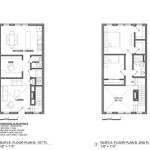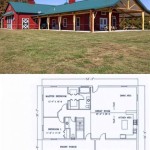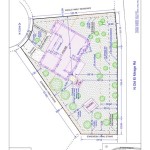Understanding Residential House Floor Plans with Dimensions
A residential house floor plan with dimensions serves as a technical drawing illustrating the layout of a home from a bird’s-eye view. This plan is a fundamental tool for architects, builders, interior designers, and homeowners, offering a precise representation of the structure’s spatial arrangement. It is a crucial component in the design, construction, and renovation processes, providing a visual blueprint that details room sizes, wall placements, door and window locations, and other essential features.
The primary purpose of a floor plan is to communicate the design intent clearly and accurately. By including specific dimensions, the plan enables accurate estimations of materials and labor costs, facilitates effective space planning, and ensures that the final construction aligns with the intended design. Without precise dimensions, the construction process becomes prone to errors, leading to potential delays, increased expenses, and discrepancies between the planned and built environments.
Floor plans are typically created using computer-aided design (CAD) software or, in some cases, drafted manually. Regardless of the method used, adherence to standardized conventions and symbols is paramount to ensure clarity and consistency across different plans. Standard symbols are used to represent various architectural elements, such as doors, windows, walls, stairs, and fixtures, allowing professionals to easily interpret the plan even when unfamiliar with the specific project.
Key Elements of a Floor Plan With Dimensions
A comprehensive floor plan with dimensions incorporates several critical elements that work together to provide a complete and understandable representation of the house. These elements range from the basic structural components to the finer details of interior fittings.
Walls: Walls are depicted as solid lines, representing the structural boundaries of the house and individual rooms. Interior walls, which divide the space within the house, are often thinner than exterior walls, which are designed to withstand environmental factors and provide insulation. The dimensions of each wall, including its length and thickness, are clearly indicated, enabling accurate calculation of wall area and material requirements.
Doors and Windows: Doors are represented as arcs indicating the direction of swing, along with the door’s width. Windows are typically shown as three parallel lines, with the center line representing the glass pane. The dimensions of both doors and windows are crucial for ensuring proper fit and function. These dimensions include the width, height, and, in the case of windows, the sill height (the distance from the floor to the bottom of the window).
Rooms and Spaces: Each room or distinct space within the house is clearly labeled with its name (e.g., “Living Room,” “Bedroom 1,” “Kitchen”). The dimensions of each room, usually its length and width, are provided, allowing for accurate calculation of the room’s area. These dimensions are essential for space planning, furniture arrangement, and determination of appropriate flooring and wall coverings. In addition to length and width, complex rooms might require dimensions indicating alcoves or offsets.
Fixtures and Appliances: Floor plans often include the location and size of significant fixtures and appliances, such as toilets, sinks, bathtubs, showers, kitchen cabinets, refrigerators, stoves, and washing machines. These items are drawn to scale and their dimensions are indicated. This information is crucial for ensuring that the plumbing and electrical infrastructure are appropriately located to support these appliances and fixtures. The placement of fixtures also influences the overall flow and functionality of the space.
Stairs: Staircases are represented by a series of lines indicating the individual steps, along with an arrow showing the direction of ascent or descent. The dimensions of each step (riser and tread) are crucial for ensuring comfortable and safe use of the stairs. The overall length and width of the staircase are also provided, which are essential for planning the layout of adjacent spaces.
Dimensions and Annotations: The inclusion of accurate dimensions is one of the most critical aspects of a floor plan. Dimensions are typically indicated using dimension lines with arrowheads pointing to the points being measured. The numerical value of the dimension is clearly displayed along the dimension line. In addition to dimensions, annotations are used to provide supplementary information, such as ceiling heights, material specifications, and notes about specific features or requirements.
Types of Dimensions Used in Floor Plans
Floor plans employ various types of dimensions to convey different aspects of the building's spatial arrangement. Understanding these dimension types is crucial for interpreting the information presented on the plan effectively.
Overall Dimensions: Overall dimensions indicate the total length and width of the entire house. These dimensions are typically placed on the exterior of the plan and provide a quick overview of the building’s footprint. These dimensions are paramount for site planning, determining setbacks from property lines, and ensuring compliance with zoning regulations.
Interior Dimensions: Interior dimensions specify the size of individual rooms and spaces within the house. These dimensions are crucial for space planning, furniture arrangement, and estimating material requirements. Interior dimensions can be provided as either “clear dimensions” (measuring the space within the walls) or “wall-to-wall dimensions” (measuring the space including the thickness of the walls).
Wall Dimensions: Wall dimensions indicate the length, thickness, and position of walls. These dimensions are essential for accurate construction and ensuring that the walls are properly aligned and positioned. Wall dimensions also help determine the amount of material needed for wall construction, such as drywall, insulation, and paint.
Opening Dimensions: Opening dimensions specify the size and location of doors and windows. These dimensions are vital for ordering the correct size doors and windows and ensuring that they fit properly within the wall openings. Opening dimensions include the width, height, and, in the case of windows, the sill height.
Location Dimensions: Location dimensions indicate the distance from a specific point to another point within the house, such as the distance from a wall to a fixture or from a corner to a window. These dimensions are crucial for accurately positioning elements within the space and ensuring that they are properly aligned with other features. Location dimensions often use a baseline or reference point from which all other dimensions are derived.
Importance of Accurate Dimensions
The accuracy of dimensions in a residential house floor plan is paramount to the success of the entire project. Inaccurate dimensions can lead to a cascade of problems, affecting everything from the initial design to the final construction.
Construction Accuracy: Accurate dimensions ensure that the building is constructed according to the designed specifications. Precise dimensions minimize errors during the building process, resulting in a structure that meets the intended design. This accuracy reduces the likelihood of costly rework and ensures that the building is structurally sound and safe.
Material Estimation: Accurate dimensions are essential for estimating the quantity of materials needed for the construction or renovation. By providing precise measurements of wall lengths, room sizes, and opening dimensions, the floor plan enables accurate calculation of material requirements, such as lumber, drywall, flooring, and paint. This accurate estimation reduces waste and prevents overspending on materials.
Cost Control: The cost of construction is directly related to the accuracy of the floor plan. Accurate dimensions allow for precise budgeting and prevent unexpected expenses due to errors in material estimation or construction. By minimizing errors and waste, accurate dimensions contribute to better cost control throughout the project.
Space Planning and Functionality: Accurate dimensions are crucial for effective space planning and ensuring that the house functions as intended. They allow homeowners and designers to plan the layout of furniture, appliances, and fixtures, ensuring that the space is both aesthetically pleasing and functional. Accurate dimensions also help determine whether the house meets the needs of the occupants and provides comfortable and efficient living spaces.
Code Compliance: Building codes often specify minimum room sizes, corridor widths, and other spatial requirements. Accurate dimensions are essential for verifying that the house complies with these codes. Non-compliance with building codes can result in fines, delays in the project, or even the need to demolish and rebuild portions of the structure.
Floor plans with dimensions are an essential tool for anyone involved in residential construction or renovation. The accuracy and clarity of these plans directly impact the success of the project, ensuring that the final result aligns with the initial design and meets the needs of the occupants.

12 Examples Of Floor Plans With Dimensions

Amazing Beautiful House Plans With All Dimensions Engineering Discoveries Create Construction Plan

How To Read A Floor Plan With Dimensions Houseplans Blog Com

How To Read A Floor Plan With Dimensions Houseplans Blog Com

12 Examples Of Floor Plans With Dimensions

A Floorplan Of Single Family House All Dimensions In Meters Scientific Diagram

Small House Design 2024001 Pinoy Eplans Floor Plans
How To Do A Floor Plan For Residential Quora

Cape Cod House Plan With 3 Bedrooms And 2 5 Baths 7645

12 Examples Of Floor Plans With Dimensions
Related Posts








